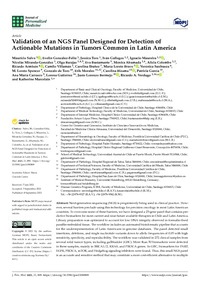Mostrar el registro sencillo de la publicación
Validation of an NGS panel designed for detection of actionable mutations in tumors common in Latin America
| dc.contributor.author | Salvo, Mauricio | |
| dc.contributor.author | González-Feliú, Evelin | |
| dc.contributor.author | Toro, Jessica | |
| dc.contributor.author | Gallegos, Ivan | |
| dc.contributor.author | Maureira, Ignacio | |
| dc.contributor.author | Miranda-González, Nicolás | |
| dc.contributor.author | Barajas, Olga | |
| dc.contributor.author | Bustamante, Eva | |
| dc.contributor.author | Ahumada, Monica | |
| dc.contributor.author | Colombo, Alicia | |
| dc.contributor.author | Armisén, Ricardo | |
| dc.contributor.author | Villamán, Camilo | |
| dc.contributor.author | Ibañez, Carolina | |
| dc.contributor.author | Bravo, María L. | |
| dc.contributor.author | Sanhueza, Verónica | |
| dc.contributor.author | Spencer, Loreto | |
| dc.contributor.author | De Toro, Gonzalo | |
| dc.contributor.author | Morales, Erik | |
| dc.contributor.author | Bizama, Carolina | |
| dc.contributor.author | García, Patricia | |
| dc.date.accessioned | 2022-08-25T18:35:42Z | |
| dc.date.available | 2022-08-25T18:35:42Z | |
| dc.date.issued | 2021 | |
| dc.identifier.uri | http://repositorio.ucm.cl/handle/ucm/4037 | |
| dc.description.abstract | Next-generation sequencing (NGS) is progressively being used in clinical practice. However, several barriers preclude using this technology for precision oncology in most Latin American countries. To overcome some of these barriers, we have designed a 25-gene panel that contains predictive biomarkers for most current and near-future available therapies in Chile and Latin America. Library preparation was optimized to account for low DNA integrity observed in formalin-fixed paraffin-embedded tissue. The workflow includes an automated bioinformatic pipeline that accounts for the underrepresentation of Latin Americans in genome databases. The panel detected small insertions, deletions, and single nucleotide variants down to allelic frequencies of 0.05 with high sensitivity, specificity, and reproducibility. The workflow was validated in 272 clinical samples from several solid tumor types, including gallbladder (GBC). More than 50 biomarkers were detected in these samples, mainly in BRCA1/2, KRAS, and PIK3CA genes. In GBC, biomarkers for PARP, EGFR, PIK3CA, mTOR, and Hedgehog signaling inhibitors were found. Thus, this small NGS panel is an accurate and sensitive method that may constitute a more cost-efficient alternative to multiple non-NGS assays and costly, large NGS panels. This kind of streamlined assay with automated bioinformatics analysis may facilitate the implementation of precision medicine in Latin America. | es_CL |
| dc.language.iso | en | es_CL |
| dc.rights | Atribución-NoComercial-SinDerivadas 3.0 Chile | * |
| dc.rights.uri | http://creativecommons.org/licenses/by-nc-nd/3.0/cl/ | * |
| dc.source | Journal of Personalized Medicine, 11(9), 899 | es_CL |
| dc.subject | NGS-panel | es_CL |
| dc.subject | Target therapies | es_CL |
| dc.subject | Predictive biomarkers | es_CL |
| dc.subject | Somatic variants | es_CL |
| dc.subject | Gallbladder cancer | es_CL |
| dc.subject | Latin America | es_CL |
| dc.title | Validation of an NGS panel designed for detection of actionable mutations in tumors common in Latin America | es_CL |
| dc.type | Article | es_CL |
| dc.ucm.facultad | Facultad de Medicina | es_CL |
| dc.ucm.indexacion | Scopus | es_CL |
| dc.ucm.indexacion | Isi | es_CL |
| dc.ucm.doi | doi.org/10.3390/jpm11090899 | es_CL |



